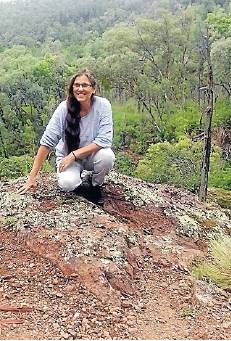Miner set to destroy Aboriginal artefacts
EXCLUSIVE
Charlotte Grieve
The world’s largest asset manager and a top superannuation fund are facing pressure to explain investments in a Chinese conglomerate set to destroy ancient Aboriginal artefacts at a coalmine in regional NSW.
China Shenhua Energy, the world’s largest thermal coalminer, is planning to construct an opencut mine next to the Liverpool plains near Gunnedah in the ‘‘food bowl’’ of the state.
The mine has been fiercely opposed by the site’s traditional owners, the Gomeroi people, who fear it will lead to the destruction of historic and culturally significant artefacts including grinding grooves showing markings of ancient warriors sharpening spears for battle, burial sites and sacred trees.
Funds management giant Black-Rock, which manages more than $10 trillion in assets including substantial amounts of Australian retirement savings and money for the Future Fund, has billions of dollars invested in China Shenhua Energy, records show.
CBUS, the $54 billion super fund for construction industry workers, also confirmed a small investment in the company, which is majority controlled by the Chinese government.
Failures by mining companies to preserve Indigenous artefacts have come into sharp focus after resources giant Rio Tinto last month destroyed a 46,000-year-old site in Western Australia against the wishes of its traditional owners.
There has also been rising scrutiny in the investment world over responsible and sustainable investing and best strategies for lifting corporate environment, social and governance standards.
The Gomeroi people last month filed submissions in the Federal Court against federal Environment Minister Sussan Ley to try to overturn the 2015 approval.
Gomeroi woman Dolly Talbott called on major institutional investors to boost transparency about where they put their clients’ money.
‘‘They have an obligation to their people investing to make sure their investors know exactly where their money is spent,’’ she said.
‘‘If you believe in preserving and looking after sacred sites, they need to know where they’re putting their money and what these companies are doing.’’
Australians should be angered about cultural artefacts that would be destroyed if the mine proceeded, which included ceremonial corridors and burial sites.
‘‘Our direct ancestors are buried out there,’’ she said. ‘‘You don’t go and blow up European burial sites so why should they be able to do that to us?
‘‘It’s totally disrespectful and it’s something the whole of Australia should be up in arms about. While it’s our history and they’re sacred to us, history should be important to all Australians.’’
China Shenhua’s annual general report released in March lists Black-Rock as owning 7.97 per cent of the company. According to Bloomberg, its stake now stands at 5.97 per cent, worth more than $3.4 billion. Blackrock did not respond to requests for comment over the investment.
CBUS confirmed it owns around $4.5 million worth of shares in the company through a passive index fund.
It was considering divesting its stake as part of its broader climate change strategy and would ask its investment managers to incorporate First Nations heritage issues into engagement strategies.
China Shenhua Energy was contacted for comment.
